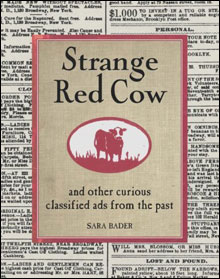 If the cow hadn’t gone off gallivanting, maybe Sara Bader wouldn’t have written her irresistible new book. But the cow did gallivant, and Bader happened to read about it while researching a documentary about the Declaration of Independence. The serendipity of her discovery is a lot like the essence of classified advertising itself, particularly the lost-and-found variety. Lost gold ring might be followed by lost artificial hand and then by lost prayer book, as in the listings of the Boston Evening Transcript for March 1, 1866.
If the cow hadn’t gone off gallivanting, maybe Sara Bader wouldn’t have written her irresistible new book. But the cow did gallivant, and Bader happened to read about it while researching a documentary about the Declaration of Independence. The serendipity of her discovery is a lot like the essence of classified advertising itself, particularly the lost-and-found variety. Lost gold ring might be followed by lost artificial hand and then by lost prayer book, as in the listings of the Boston Evening Transcript for March 1, 1866.
Zooming in on life’s random ephemera, classified ads can, it turns out, reanimate the past like nothing else. They can tell you about what people valued or wanted, whether it was to locate a lost green parrot that “speaks Spanish like a native” or to hire “a young lady of German parentage,” who “must be a 36 bust and understand bookkeeping on a small scale.”
Strange Red Cow sets classifieds against the larger doings of history, detailing, for instance, how information-wanted postings were linked to the Irish potato famine of the 1840s and to Emancipation. (In both cases, many people were searching for lost family and friends.) During the Depression, swap ads were common, and desperation sometimes bred absurdity: a “Funk & Wagnall’s Standard Desk Dictionary for lightish sledge hammer or dung fork in fair condition.” Or the books Woman, Her Sex and Love Life and Birth Control, “by eminent physician,” for “ten hens of heavy breed or pigs.”
The title bovine ad read: “Came to my plantation . . . a strange red cow. The owner may have her again, on proving his property, and paying charges.” It was placed by Philip Miller in the Pennsylvania Gazette of May 1 1776. Bader writes, “I pictured Mr. Miller discovering that stray cow on his plantation, sizing her up, and checking for any identifying marks. Perhaps he went straight home, sat down at a writing table, and with the tip of his quill wet with ink, composed those lines.”
 In the section “Bestial Wanderlust,” we learn about cows, horses, pigs, sheep, and hens who’ve flown the coop. New York City, especially, was much more zoo-like in 1850, what with 200-plus slaughterhouses, and gangs of cows and pigs roaming the streets. Sometimes people lost peculiar creatures, such as the “curiously deformed Hen, without a beak, and head shaped somewhat like a monkey; highly valued as a curiosity.” The phrasing can seem quaint, as in the case of the missing pig “who was last seen at full speed taking an air line for Vassalborough the place of his nativity.” Or the lost cow named Nellie, “young and in good order, with left horn damaged from contact with locomotive.” Not so quaint is the way runaway-slave notices tended to read like lost-livestock ads, with slave masters sometimes forgetting their slaves’ names but recalling physical details down to the smallest wart.
In the section “Bestial Wanderlust,” we learn about cows, horses, pigs, sheep, and hens who’ve flown the coop. New York City, especially, was much more zoo-like in 1850, what with 200-plus slaughterhouses, and gangs of cows and pigs roaming the streets. Sometimes people lost peculiar creatures, such as the “curiously deformed Hen, without a beak, and head shaped somewhat like a monkey; highly valued as a curiosity.” The phrasing can seem quaint, as in the case of the missing pig “who was last seen at full speed taking an air line for Vassalborough the place of his nativity.” Or the lost cow named Nellie, “young and in good order, with left horn damaged from contact with locomotive.” Not so quaint is the way runaway-slave notices tended to read like lost-livestock ads, with slave masters sometimes forgetting their slaves’ names but recalling physical details down to the smallest wart.
One thing about personal ads that hasn’t changed since at least the 1860s is the “chance encounter” or “missed connection.” “If the lady who, from an omnibus, smiled on a gentleman with a bunch of bananas in his hand, as he crossed Wall street, corner of Broadway, will address X., box 6735 Post office, she will confer a favor.” Bader also digs up choice Mark Twain responses: “There seems to be a pack of wooden-headed louts about this town who fall in love with every old strumpet who smiles a flabby smile at them in a street car, and forthwith they pop a personal into the Herald.”
Years later, only the method has changed. The strumpets still smile at the louts, and the louts, ever hopeful, post an ad on craigslist.
On the Web
Sarah Bader's Classified Archive: //www.classifiedarchive.org